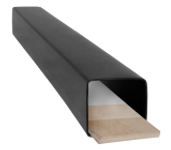About this product
Dormouse nest tubes provide a cheap and easy method of determining the presence of dormice within a habitat. They can be an effective alternative to using a large number of more expensive wooden nest boxes.
The nest tube consists of two parts - the wooden 'tray' and the 'nesting tube' (also available separately). The tray, made from 3-ply, fits securely inside the nesting tube (made from plastic tree guard material), with a wooden block sealing the tube at one end. Dormice make nests in these tubes and it is these that are used as indicators of their presence in the habitat.
Tubes can be easily assembled in the field and are secured to tree branches using cable ties (not included). Our innovative new design features flip-out tabs through which cable ties can be threaded and enable tubes to be more easily and securely attached to branches.
Where should nest tubes be used?
Dormice usually inhabit deciduous woodland or overgrown hedgerows and feed mostly on fruits, nuts, seeds, insects and flowers. Dormouse generally require habitat with enough plant diversity to provide food supplies through the summer. The structure of the habitat is also important - dormice are predominantly arboreal and use lateral branches and sprawling bushes as runways to move about without descending to the ground. Nest tubes can be used to determine presence of dormice in unknown habitats and as they are increasingly being found in habitats which lack the conventional characteristics, it is worth using tubes in a range of locations.
When is the best time to start using dormouse tubes?
For best results, nest tubes should be in place by early April in time to attract dormice when they first come out of hibernation in late April and early May, but as they may also be occupied throughout the summer, the exact time of deployment is not critical. Hibernation begins again in the autumn so using tubes throughout the winter period is not necessary.
Where should dormouse nest tubes be used?
The likelihood of finding dormice increases with the number of tubes used. A minimum of 50 tubes at one time is recommended (depending on the size of the habitat being surveyed) and should be sited about 15-20m apart at a variety of heights above ground level. Tubes should be attached to the hedgerow or tree underneath horizontal branches using cable ties or wire at both ends to secure the tube. When assembled, the wooden tray extends out of the plastic tube and creates a rough surface that the dormouse can grip on to gain access to the nest. The tube opening should face into the centre of the hedge.
Tubes should be checked for nests every fortnight and once dormice are detected, the tubes can be taken down and replaced with wooden nest boxes or left in place to carry out further survey work.
Dormice are legally protected under the Wildlife & Countryside Act 1981 and must not be handled unless you have a licence to do so. Nest tubes can be set up and checked without a licence until the first dormouse is found. After that only a licensed handler can check them.
For more information, take a look at our NHBS Guide to Dormouse Survey Equipment blog.
Specification
- Length: 297mm
- Width: 67mm
- Depth: 67mm
- Weight: 130g
Customer Reviews






















